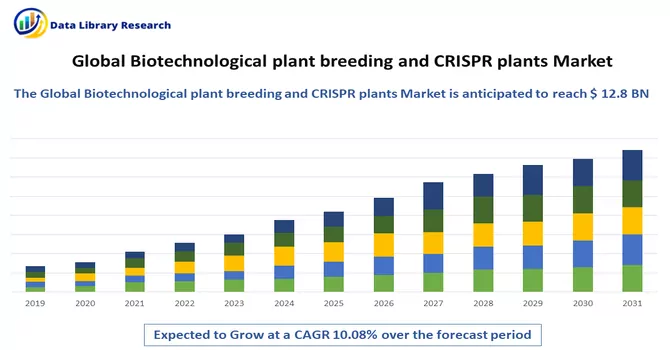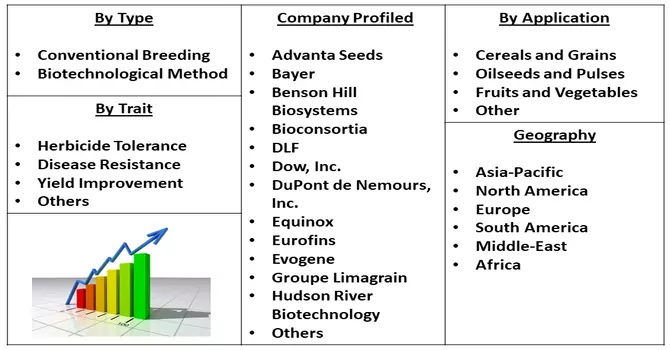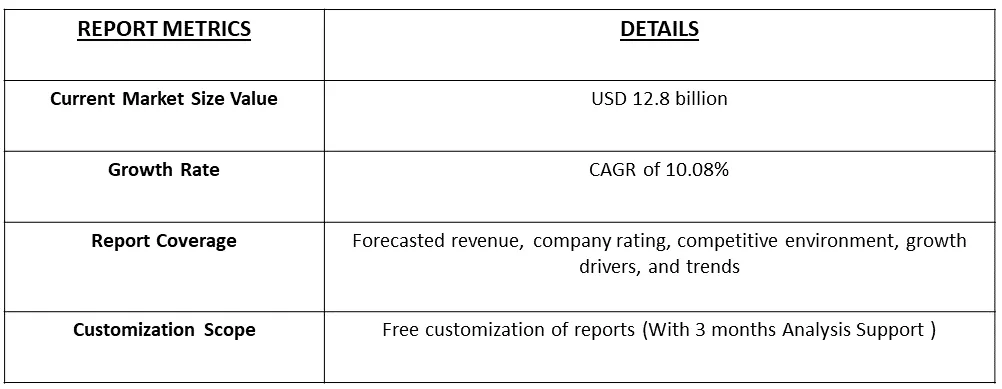The Biotechnological Plant Breeding and CRISPR Plants Market is currently valued at USD 12.8 billion, registering a CAGR of 10.08% over the forecast period, 2023-2030.

Get Complete Analysis Of The Report - Download Free Sample PDF
Plant breeding is a technique used by farmers to create new crop varieties, enhance existing ones, and boost yields by modifying the plant genome using molecular or conservatory tools to obtain the desired gene or trait. The site-directed nuclease method is used in plant breeding to target or transform the DNA into the desired DNA. A CRISPR-Cas gene derived from a prokaryote is used in plant breeding to alter the plant genome to produce germplasm with superior and advantageous traits.
Crops created through plant breeding or CRISPR technology often have traits like high yield, superior quality to traditional crops, disease resistance, herbicide tolerance, climatic tolerance, and others. Additionally, crops are developed using plant breeding techniques to provide a range of advantages, including higher yield, better quality, disease resistance, and others. Additionally, the best sustainable crop production option is plant breeding and CRISPR technology.
The growing population is one of the main driving factors for plant breeding & and CRISPR plants. With the growing population, the demand for food is increasing, and there are a greater number of people to feed, which is increasing the need for new plant breeding technology. The demand for improved plant varieties is increasing among farmers and people to eliminate the food scarcity problem with the growing population globally.
The innovations in plant breeding use sophisticated science and technology that include speed breeding, genomic selection, gene mapping, precision phenotyping, mutations, and marker-assisted breeding (MAB).
Segmentation:
The Biotechnological Plant Breeding and CRISPR Plants Market is Segmented by Process
Mass Selection Pure Line Selectio Hybridization Mutation Breeding Type Conventional Breeding Biotechnological Breeding Hybrid Breeding Molecular Breeding Genetic Breeding Genomic Editing Traits Herbicide Tolerance Disease Resistance Yield Improvement Other Traits Application Cereals & Grains Oilseeds & Pulses Fruits & Vegetables Other Crop Types Geography North America Europe Asia-Pacific South America Middle East Africa The report offers market size and values in (USD million) during the forecasted years for the above segments.

For Detailed Market Segmentation - Download Free Sample PDF
Drivers:
Rise in Demand for Improved Crop Varieties Using Modern Breeding Techniques
Modern plant breeding may use techniques of molecular biology to select, or in the case of genetic modification, to insert, desirable traits into plants. The application of biotechnology or molecular biology is also known as molecular breeding. Modern facilities in molecular biology are now used in plant breeding. Furthermore, the recent developments in CRISPR technology and plant breeding are expected to contribute to the studied market growth.
For instance, in February 2022, The Innovative Genomics Institute partnered with the African Orphan Crops Consortium (AOCC), the Seed Biotechnology Center at UC Davis, and the International Institute of Tropical Agriculture, to introduce a new course on CRISPR genome editing in agriculture as part of the African Plant Breeding Academy (AfPBA). It will empower 80 to 100 African scientists to implement genome editing technologies to fast-track the engineering of vital traits in food crops. CRISPR holds huge promise for plant breeders to make precise genetic changes, providing a new tool to help farmers rise to the challenges of a changing climate and rapidly growing population. Thus, such developments are contributing to the growth of the studied market.
Technological Advancement Ensures Strong Market Growth.
The technological advancements in CRISPR technology in plant breeding are expected to contribute to the growth of this segment. For instance, in August 2022, Researchers at the University of the Philippines Los Baños (UPLB) led by Dr. Lourdes D. Taylo are using innovative technologies to develop improved eggplant varieties that are resistant to eggplant fruit and shoot borer (EFSB) and leafhopper (LH). The multi-disciplinary team is using genomics, IT-based phenotyping platforms, molecular marker technologies, and new breeding techniques to fast-track this development. Thus, such developments are contributing to the growth of the studied market.
Restraint:
High Cost of Modern Breeding Methods as Compared to Conventional Methods.
The biotechnological advanced methods like CRISPR technologies offer several advantages like increasing crop productivity by introducing such qualities as disease resistance and increased drought tolerance to the crops. Also, the researchers can select genes for disease resistance from other species and transfer them to important crops. These methods although proven to be highly advantageous over the conventional breeding methods are quite expensive. The average cost for CRISPR bacterium right at home accounts for USD 200 (INR 16,000) which is estimated to be quite expensive for developing countries like India and thus expected to slow down the growth of the studied market over the forecast period.
Segmental Analysis:
Mutation Breeding Segment is Expected to Witness Significant growth Over the Forecast Period.
Plant mutation breeding, also called variation breeding, is a method that uses physical radiation or chemical means to induce spontaneous genetic variation in plants to develop new crop varieties. Furthermore, the recent developments are expected to fuel the growth of this segment. For instance, in August 2019, the IAEA launched the Plant Mutation Breeding Network for Asia and the Pacific. An initiative led by the IAEA and the Food and Agriculture Organization of the United Nations (FAO) is bringing together experts from across the region to support one another and build on each other’s research, breeding, and cultivation results.
Molecular Breeding Segment is Expected to Witness High Growth Over the Forecast Period.
Molecular breeding, or MAS, refers to the technique of using DNA markers that are tightly linked to phenotypic traits to assist in a selection scheme for a particular breeding objective. Molecular plant breeding expands useful genetic diversity for crop improvement. The maximum potential for genetic gain is proportional to the phenotypic variation present in the source population and maintained in subsequent cycles of selection.
North American Region is Expected to Witness High Growth Over the Forecast Period.
North American region is expected to witness significant growth over the forecast period owing to the growing awareness regarding the benefits of plant breeding & and CRISPR plants in the agricultural sector and also the high adoption rate of plant-breaded crops in the Latin America region. The factors that are restraining the growth of plant breeding & and CRISPR plants are the increase in awareness regarding the presence of undesired toxins in plant breeding crops which can potentially be hazardous to human health.
Also, the recent developments in the region are expected to drive the studied market’s growth. For instance, In August 2022, Bayer expanded existing investment to acquire a majority stake in sustainable low-carbon oilseed producer CoverCress Inc. This investment fulfilled Bayer's sustainability commitments and can help reduce agricultural carbon emissions and reduce dependence on nitrogen fertilizers by leveraging the expertise of existing investors, Bunge and Chevron/farmers to gain new revenue streams through the potential commercialization of oilseeds into renewable fuels and animal feed that deliver ecosystem benefits through cover crops, leveraging Bayer's existing investment in CoverCress Inc. This has helped the company to expand its business.

Get Complete Analysis Of The Report - Download Free Sample PDF
Competitive Landscape:
The Biotechnological Plant Breeding and CRISPR Plants Market is highly competitive due to the presence of many players working globally and regionally in this market segment. Some of the major players working in this market segment are:
Key Players :
Recent Developments:
1) In May 2023: Pairwise, a pioneering food startup, launched its inaugural product, Conscious Greens, under its Conscious Foods brand. The product is the first food introduced in the U.S. that was developed with CRISPR technology. Conscious Greens Purple Power Baby Greens Blend, which will be co-branded with Performance Food Group’s Peak Fresh Produce brand, is a mix of colorful Superfood leafy greens with a unique, fresh flavor and up to double the nutrition of romaine. Using CRISPR technologies to improve taste and nutrition in produce, Conscious Greens are field-grown Superfood greens that eat like lettuce, offering a versatile new option for chefs and salad lovers alike
2) In June 2023: GreenVenus, LLC, a biotechnology company specializing in genetic engineering for sustainable agriculture, reported a groundbreaking achievement in avocado gene editing and plant regeneration. GreenVenus's scientists have successfully modified a key gene associated with fruit browning, opening new possibilities for producing higher-quality avocados. Using CRISPR editing, GreenVenus successfully produced multiple lines of avocados with enhanced resistance to browning by "knocking out" a key gene in the browning pathway, polyphenol oxidase (PPO). Several elite commercial varieties are in the developmental pipeline; some are currently under analysis.
Q1. What is the current Biotechnological plant breeding and CRISPR plants Market size?
The Biotechnological Plant Breeding and CRISPR Plants Market is currently valued at USD 12.8 billion.
Q2. What is the Growth Rate of the Biotechnological plant breeding and CRISPR plants Market?
Biotechnological plant breeding and CRISPR plants Market is registering a CAGR of 10.08% over the forecast period.
Q3. What are the Growth Drivers of the Biotechnological plant breeding and CRISPR plants Market?
Rise in Demand for Improved Crop Varieties Using Modern Breeding Techniques are the Growth Drivers of the Biotechnological plant breeding and CRISPR plants Market.
Q4. Which Region is expected to hold the highest Market share?
North American region is expected to hold the highest Market share.
Data Library Research are conducted by industry experts who offer insight on industry structure, market segmentations technology assessment and competitive landscape (CL), and penetration, as well as on emerging trends. Their analysis is based on primary interviews (~ 80%) and secondary research (~ 20%) as well as years of professional expertise in their respective industries. Adding to this, by analysing historical trends and current market positions, our analysts predict where the market will be headed for the next five years. Furthermore, the varying trends of segment & categories geographically presented are also studied and the estimated based on the primary & secondary research.
In this particular report from the supply side Data Library Research has conducted primary surveys (interviews) with the key level executives (VP, CEO’s, Marketing Director, Business Development Manager and SOFT) of the companies that active & prominent as well as the midsized organization
FIGURE 1: DLR RESEARH PROCESS

Extensive primary research was conducted to gain a deeper insight of the market and industry performance. The analysis is based on both primary and secondary research as well as years of professional expertise in the respective industries.
In addition to analysing current and historical trends, our analysts predict where the market is headed over the next five years.
It varies by segment for these categories geographically presented in the list of market tables. Speaking about this particular report we have conducted primary surveys (interviews) with the key level executives (VP, CEO’s, Marketing Director, Business Development Manager and many more) of the major players active in the market.
Secondary ResearchSecondary research was mainly used to collect and identify information useful for the extensive, technical, market-oriented, and Friend’s study of the Global Extra Neutral Alcohol. It was also used to obtain key information about major players, market classification and segmentation according to the industry trends, geographical markets, and developments related to the market and technology perspectives. For this study, analysts have gathered information from various credible sources, such as annual reports, sec filings, journals, white papers, SOFT presentations, and company web sites.
Market Size EstimationBoth, top-down and bottom-up approaches were used to estimate and validate the size of the Global market and to estimate the size of various other dependent submarkets in the overall Extra Neutral Alcohol. The key players in the market were identified through secondary research and their market contributions in the respective geographies were determined through primary and secondary research.
Forecast Model
